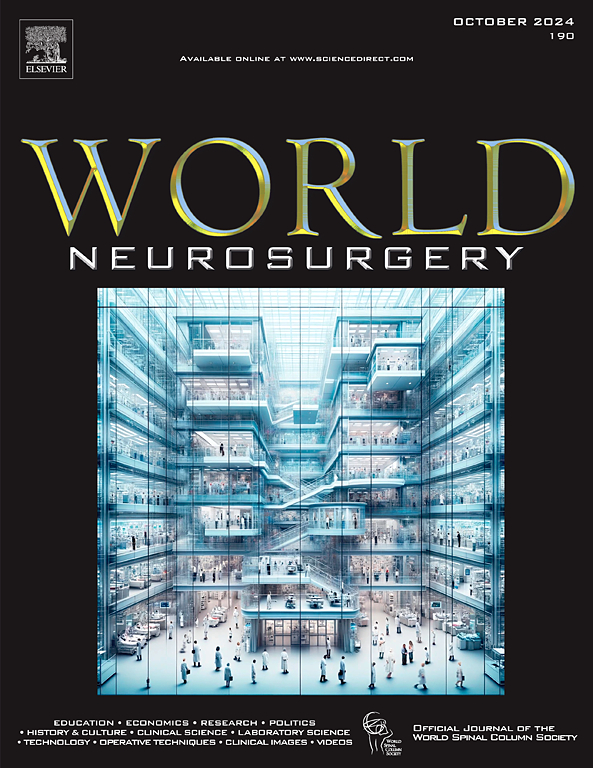Evaluation of Hidden Blood Loss and Clinical Outcomes of Arthroscopy-Assisted Uni-Portal Spinal Surgery for Lumbar Disc Herniation with Lateral Recess Stenosis
IF 1.9
4区 医学
Q3 CLINICAL NEUROLOGY
引用次数: 0
Abstract
Objective
This study aims to evaluate hidden blood loss (HBL) and its influencing factors in patients with lumbar disc herniation-related lateral recess stenosis who underwent arthroscopy-assisted uni-portal spinal surgery (AUSS). Additionally, the study assesses clinical outcomes at the 6-month postoperative follow-up.
Methods
This study included 129 patients with lumbar disc herniation-associated lateral recess stenosis who underwent AUSS during the year 2024. Demographic data and parameters related to blood loss were recorded. HBL was calculated using the Nadler and Gross formulas. Pearson or Spearman correlation analyses were performed to explore the relationships between patient characteristics and HBL. Multiple linear regression analysis was used to identify independent risk factors for HBL. Primary clinical outcomes (visual analog scale scores) and secondary outcomes (Oswestry Disability Index scores and the modified Macnab criteria) were assessed preoperatively and at 3 days, 3 months, and 6 months postoperatively. Longitudinal data were analyzed using generalized mixed linear models.
Results
A total of 129 consecutive patients (66 females and 63 males) were enrolled. The average HBL was 414.34 ± 179.15 ml. Correlation analyses (Pearson and Spearman) revealed significant associations between surgical duration, American Society of Anesthesiologists (ASA) score, muscle thickness, preoperative activated partial thromboplastin time, and preoperative D-dimer with HBL (P < 0.05). Multiple linear regression analysis identified surgical duration and ASA score as independent risk factors for HBL. Postoperative visual analog scale and Oswestry Disability Index scores showed significant improvement compared to preoperative values.
Conclusions
The amount of HBL in patients undergoing AUSS should not be underestimated. ASA score and surgical duration are independent risk factors for HBL. AUSS, as an improved technique, significantly alleviates postoperative pain and enhances quality of life, demonstrating good short-term clinical efficacy. It is an effective treatment option for lateral recess stenosis caused by lumbar disc herniation.
关节镜辅助单孔脊柱手术治疗伴有侧隐窝狭窄的腰椎间盘突出症的隐性失血量及临床疗效评价。
目的:探讨关节镜辅助下单孔脊柱手术(AUSS)治疗腰椎间盘突出相关侧隐窝狭窄患者隐性失血量(HBL)及其影响因素。此外,该研究评估了术后6个月随访的临床结果。方法:本研究纳入了2024年期间129例腰椎间盘突出相关的侧隐窝狭窄患者。记录与失血量相关的人口学数据和参数。HBL采用Nadler和Gross公式计算。采用Pearson或Spearman相关分析探讨患者特征与HBL之间的关系。采用多元线性回归分析确定HBL的独立危险因素。术前、术后3天、3个月和6个月评估主要临床结局(视觉模拟量表[VAS]评分)和次要结局(Oswestry残疾指数[ODI]评分和改良的Macnab标准)。纵向数据采用广义混合线性模型进行分析。结果:共入组129例患者(女性66例,男性63例)。平均HBL为414.34±179.15 ml。相关分析(Pearson和Spearman)显示,手术时间、ASA评分、肌肉厚度、术前APTT、术前d -二聚体与HBL有显著相关性(P < 0.05)。多元线性回归分析发现手术时间和ASA评分是HBL的独立危险因素。术后VAS和ODI评分较术前有明显改善。结论:AUSS患者HBL的数量不可低估。ASA评分和手术时间是HBL的独立危险因素。AUSS作为一种改良技术,明显减轻了术后疼痛,提高了生活质量,近期临床疗效良好。对于腰椎间盘突出引起的侧隐窝狭窄是一种有效的治疗方法。
本文章由计算机程序翻译,如有差异,请以英文原文为准。
求助全文
约1分钟内获得全文
求助全文
来源期刊

World neurosurgery
CLINICAL NEUROLOGY-SURGERY
CiteScore
3.90
自引率
15.00%
发文量
1765
审稿时长
47 days
期刊介绍:
World Neurosurgery has an open access mirror journal World Neurosurgery: X, sharing the same aims and scope, editorial team, submission system and rigorous peer review.
The journal''s mission is to:
-To provide a first-class international forum and a 2-way conduit for dialogue that is relevant to neurosurgeons and providers who care for neurosurgery patients. The categories of the exchanged information include clinical and basic science, as well as global information that provide social, political, educational, economic, cultural or societal insights and knowledge that are of significance and relevance to worldwide neurosurgery patient care.
-To act as a primary intellectual catalyst for the stimulation of creativity, the creation of new knowledge, and the enhancement of quality neurosurgical care worldwide.
-To provide a forum for communication that enriches the lives of all neurosurgeons and their colleagues; and, in so doing, enriches the lives of their patients.
Topics to be addressed in World Neurosurgery include: EDUCATION, ECONOMICS, RESEARCH, POLITICS, HISTORY, CULTURE, CLINICAL SCIENCE, LABORATORY SCIENCE, TECHNOLOGY, OPERATIVE TECHNIQUES, CLINICAL IMAGES, VIDEOS
 求助内容:
求助内容: 应助结果提醒方式:
应助结果提醒方式:


